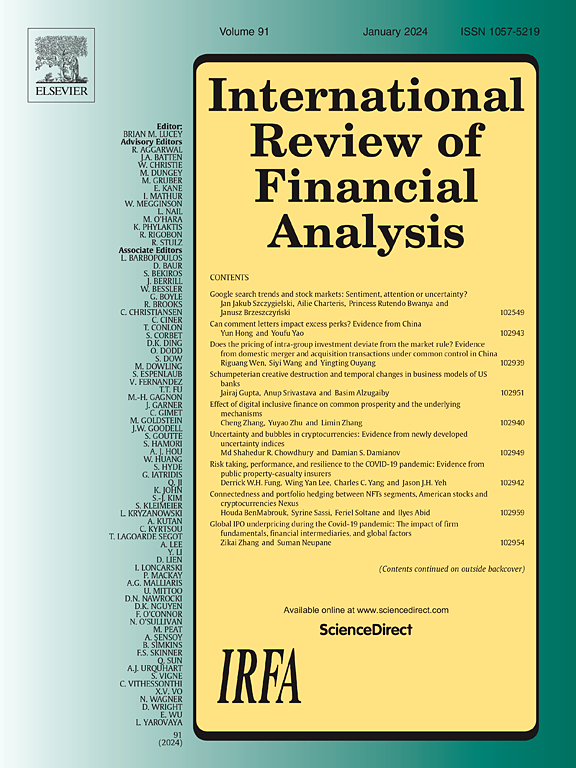杠杆效应、波动性、创新溢出以及加密货币和差价合约对股指的市场间和市场内不对称依赖:来自高频全天候数据的证据
IF 9.8
1区 经济学
Q1 BUSINESS, FINANCE
引用次数: 0
摘要
这项研究使用5分钟的全天候高频数据,首次全面研究了美国、英国、法国、德国、澳大利亚和日本六个主要发达股票市场之间的不对称杠杆效应、波动性创新溢出效应和依赖关系,以及七种主要的经过充分研究的加密货币:比特币(BTC)、莱特币(LTC)、以太币(ETH)、达世币(DSH)、EOS、Tron (TRX)和Basic Attention Token (BAT)。我们采用非交易期股票指数的差价合约(cfd)数据,几种基于garch的对称和非对称计量经济工具,以及从2019年8月5日到2023年1月31日的综合样本期,包括每种资产的363,024个观察值。使用符号偏倚检验,我们首先发现加密货币的杠杆效应——负面创新对回报条件波动的影响比同等规模的积极创新更大——在后covid时期更为明显,而在股票中,它们存在于整个样本时期,除了Covid-19的第一年,这与担心在快速复苏和繁荣时期错过的概念相一致。使用SAARCH、TGARCH和APARCH模型,这种不对称杠杆效应是稳健的。我们证明,由于创新(滞后标准化误差),加密货币之间以及股票和加密货币之间的溢出效应强于持久性(滞后条件协方差)。关于跨类别资产对冲机会,我们通过创新项的负系数来衡量,我们发现配对英国- ltc,美国- dsh,德国- dsh,美国- eos,日本- eos和德国- trx最有可能为投资者提供多种多元化收益。此外,我们研究了类间资产设置中的不对称动态条件相关性,发现加密货币中的BAT和LTC以及股票中的澳大利亚和法国市场与其他资产类别的关联较弱,这表明它们在投资组合优化中的潜在作用。我们的研究结果具有实际意义,并指导投资者在不同的经济、地缘政治和市场条件下全天候做出对冲和多元化决策,以及优化加密货币股票投资组合。本文章由计算机程序翻译,如有差异,请以英文原文为准。
Leverage effects, volatility innovation spillovers, and inter- and intra-market asymmetric dependencies in cryptocurrencies and CFDs on equity indices: Evidence from high-frequency around-the-clock data
Using 5-min high-frequency data around-the-clock, this study is the first to comprehensively examine asymmetric leverage effects, volatility innovation spillovers, and dependencies between six major developed equity markets – US, UK, France, Germany, Australia, and Japan – and seven major well-studied cryptocurrencies: Bitcoin (BTC), Litecoin (LTC), Ether (ETH), Dash (DSH), EOS, Tron (TRX), and Basic Attention Token (BAT). We employ the contract for differences (CFDs) on the equity indices for data during non-trading periods, several symmetric and asymmetric GARCH-based econometric tools, and a comprehensive sample period spanning from August 5, 2019, to January 31, 2023, consisting of 363,024 observations for each asset. Using sign bias tests, we first identify that leverage effects – a stronger impact of negative innovations on the conditional volatility of returns than the positive innovations of the same size – in cryptocurrencies are more pronounced in the post-Covid period, whereas in equities, they exisit across the sample period, except the first year of the Covid-19, consistent with the notion of fear of missing out during rapid recovery and boom periods. This asymmetric leverage effect is robust using the SAARCH, TGARCH, and APARCH models. We document that spillovers among cryptocurrencies and between equities and cryptocurrencies due to innovation (lagged standardized errors) are stronger than those of persistence (lagged conditional covariances). Regarding inter-class asset hedging opportunities, which we measure via negative coefficients of the innovation term, we find that pairing UK-LTC, US-DSH, Germany-DSH, US-EOS, Japan-EOS, and Germany-TRX are most likely to offer several diversification benefits to investors. Additionally, we examine asymmetric dynamic conditional correlations in inter-class asset settings and find that BAT and LTC among cryptocurrencies and the Australian and French markets among equities are weakly connected with other asset classes, suggesting their potential role in portfolio optimization. Our findings hold practical importance and guide investors in making hedging and diversification decisions and in optimizing cryptocurrency-equity portfolios during different economic, geopolitical, and market conditions around the clock.
求助全文
通过发布文献求助,成功后即可免费获取论文全文。
去求助
来源期刊

International Review of Financial Analysis
BUSINESS, FINANCE-
CiteScore
10.30
自引率
9.80%
发文量
366
期刊介绍:
The International Review of Financial Analysis (IRFA) is an impartial refereed journal designed to serve as a platform for high-quality financial research. It welcomes a diverse range of financial research topics and maintains an unbiased selection process. While not limited to U.S.-centric subjects, IRFA, as its title suggests, is open to valuable research contributions from around the world.
 求助内容:
求助内容: 应助结果提醒方式:
应助结果提醒方式:


